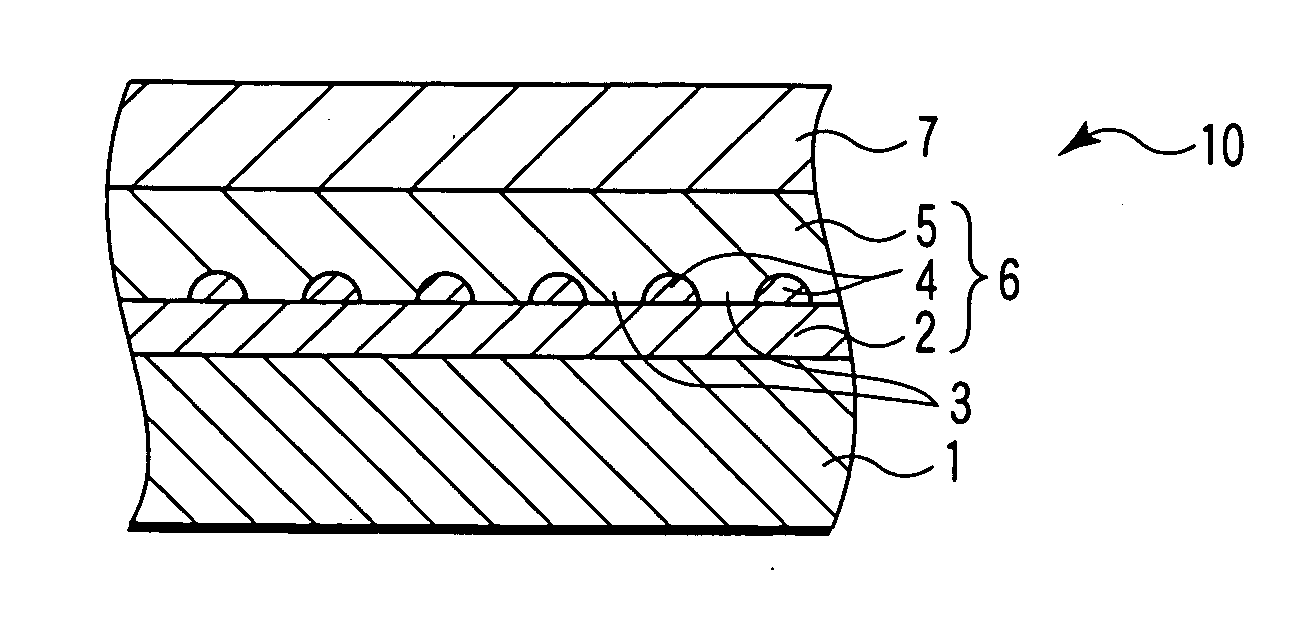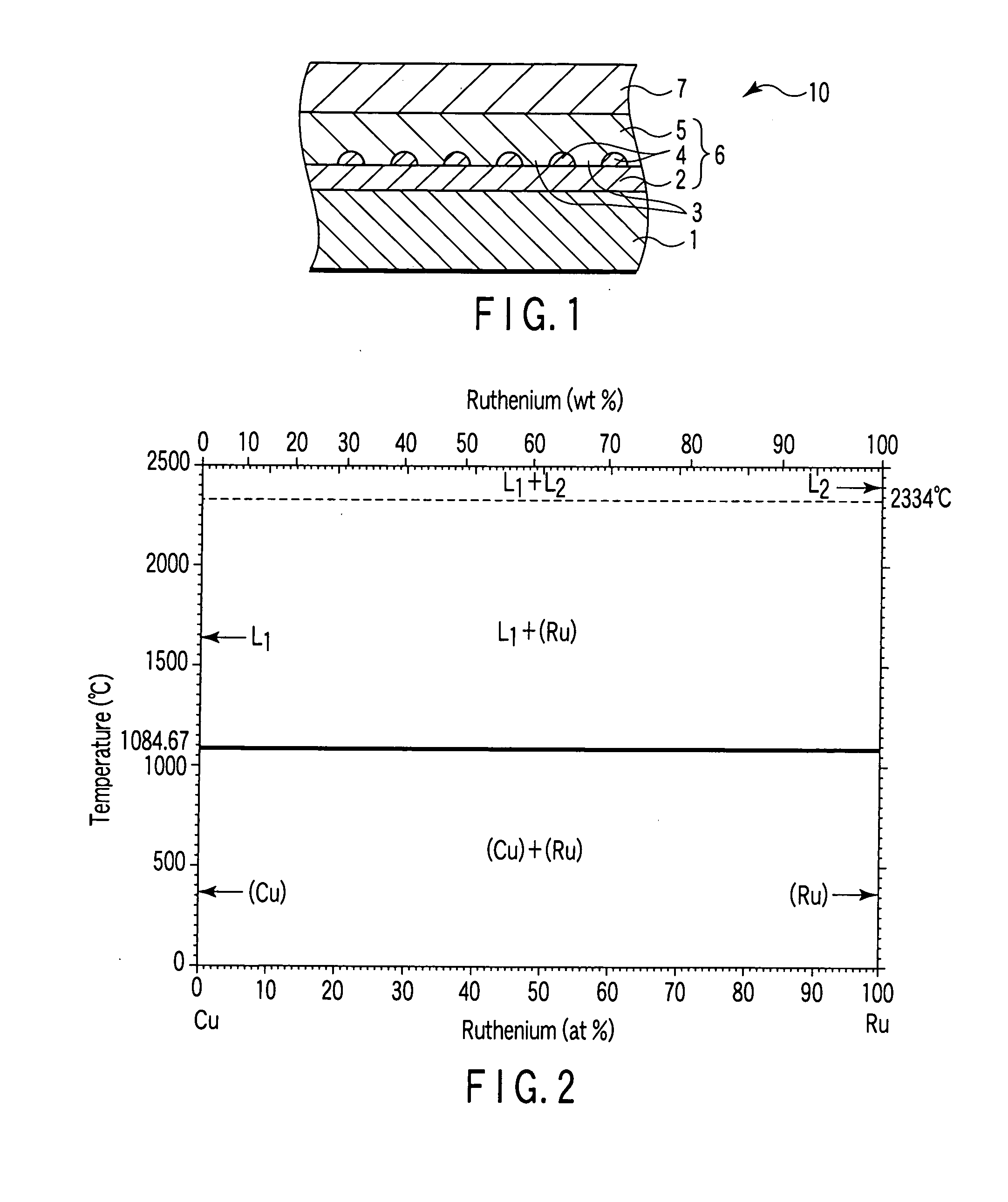Perpendicular magnetic recording medium and perpendicular magnetic recording/reproducing apparatus
a technology of perpendicular magnetic recording and recording medium, which is applied in the direction of magnetic recording, data recording, instruments, etc., can solve the problems of easy deterioration of crystal orientation, difficult further reduction, and often natural determination of grain siz
- Summary
- Abstract
- Description
- Claims
- Application Information
AI Technical Summary
Benefits of technology
Problems solved by technology
Method used
Image
Examples
experimental embodiment 1
[0112] Manufacture of perpendicular magnetic recording medium
[0113] A disk-like cleaned glass substrate (manufactured by Ohara, outer diameter=2.5 in.) was prepared as a nonmagnetic substrate. This glass substrate was placed in a film formation chamber of a magnetron sputtering apparatus (C-3010 manufactured by Anelva), and the film formation chamber was evacuated until the base pressure of 2×10−5 Pa or less. After that, sputtering was sequentially performed as follows in an Ar ambient at a gas pressure of 0.6 Pa.
[0114] First, a 100-nm thick CoZrNb alloy was formed as a soft magnetic layer on the nonmagnetic substrate.
[0115] Then, a multilayered underlayer including first, second, and third metal underlayers was formed as follows.
[0116] Next, a 5-nm thick Ti film was formed as the first metal underlayer.
[0117] Measurements were performed using an atomic force microscope (AFM) and X-ray diffractometer (XRD) in a case in which a Ti layer was stacked on a CrZrNb soft magnetic laye...
experimental embodiment 2
[0166] Perpendicular magnetic recording media were manufactured following the same procedures as in Experimental Embodiment 1 except that Ni, Rh, Pd, Pt, Ag, and Au having the same fcc as Cu were used as the second metal underlayer instead of Cu.
[0167] As in Experimental Embodiment 1, to check the growth of metal crystal grains, the film formation was stopped when these second metal materials were sputtered, and AFM measurements were performed.
[0168] The surface roughness increased when the sputtering amount of the second metal underlayer was increased or decreased, where necessary, within the range equivalent to an average layer thickness of about 0.5 to 2 nm. Therefore, it is presumably possible, depending on the film formation conditions, to form metal grains into islands and obtain a second metal underlayer having holes, regardless of the metal material used as the second metal underlayer.
[0169] Then, to check the grain size of Ru, plane view TEM observation was performed on ...
experimental embodiment 3
[0174] Perpendicular magnetic recording media were manufactured following the same procedures as in Experimental Embodiment 1 except that Ni, Rh, Pd, Pt, Ag, Au, Nb, and Ta were used as the first metal underlayer instead of Ti.
[0175] As in Experimental Embodiment 1, to check the growth of metal grains, the film formation was stopped when Cu was sputtered on the first metal underlayer, and AFM measurements were performed.
[0176] The surface roughness increased when the sputtering amount of Cu was increased or decreased, where necessary, within the range equivalent to an average layer thickness of about 0.5 to 2 nm.
[0177] Since the sputtering amount was small, therefore, it is presumably possible, depending on the film formation conditions, to form metal grains into islands and obtain a second metal underlayer having holes on the first metal underlayer, regardless of the metal material.
[0178] Then, to check the grain size of Ru, plane view TEM observation was performed on the state...
PUM
 Login to View More
Login to View More Abstract
Description
Claims
Application Information
 Login to View More
Login to View More - R&D
- Intellectual Property
- Life Sciences
- Materials
- Tech Scout
- Unparalleled Data Quality
- Higher Quality Content
- 60% Fewer Hallucinations
Browse by: Latest US Patents, China's latest patents, Technical Efficacy Thesaurus, Application Domain, Technology Topic, Popular Technical Reports.
© 2025 PatSnap. All rights reserved.Legal|Privacy policy|Modern Slavery Act Transparency Statement|Sitemap|About US| Contact US: help@patsnap.com



